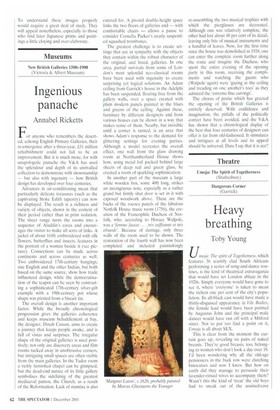New British Galleries 1500-1900 (Victoria & Albert Museum)
Ingenious panache
Annabel Ricketts
For anyone who remembers the deserted, echoing English Primary Galleries, their re-emergence after a three-year, £31 million refurbishment could not fail to be an improvement. But it is much more, for with unapologetic panache the V&A has used the splendour and depth of its unrivalled collection to demonstrate with showmanship — but also with ingenuity — how British design has developed over four centuries.
Advances in air-conditioning mean that particularly delicate treasures (such as the captivating Stoke Edith tapestry) can now be displayed. The result is a richness and variety of objects, shown in the context of their period rather than in prim isolation. The sheer range turns the rooms into a sequence of Aladdin's caves and encourages the visitor to make all sorts of links. A jacket of about 1610, embroidered with silk flowers, butterflies and insects, features in the portrait of a woman beside it (see picture). Connections can be made across continents and across centuries as well. Two embroidered 17th-century hangings, one English and the other Indian, but both based on the same source, show how trade influenced design, while the democratisation of the teapot can be seen by contrasting a sophisticated 17th-century silver-gilt example with a 19th-century pot whose shape was pirated from a biscuit tin.
The overall design is another important factor. While the broadly chronological progression gives the galleries coherence and keeps museum befuddlement at hay, the designer, Dinah Casson, aims to create a journey that keeps people awake, and is full of vistas and surprises. The irregular shape of the original galleries is used positively; not only are discovery areas and film rooms tucked away in unobtrusive corners, but intriguing small spaces are often visible from the main galleries. In the Tudor room a richly furnished chapel can be glimpsed, but the dead-end nature of its little gallery symbolises the sidelining of the greatest mediaeval patron, the Church, as a result of the Reformation. Lack of stamina is also catered for, A pivotal double-height space links the two floors of galleries and — with comfortable chairs — allows a pause to consider Cornelia Parker's neatly suspended squashed trombones.
The greatest challenge is to create settings that are in sympathy with the objects they contain within the robust character of the original, and listed, galleries. In one area, partial survivals from some of London's most splendid neo-classical rooms have been used with ingenuity to create surprising yet logical solutions. An Adam ceiling from Garrick's house in the Adelphi has been suspended, floating free from the gallery walls, over a space created with plain modern panels painted in the blues and greens of the ceiling. Against these, furniture by different designers and from various houses can be shown in a way that makes sense of them. Nearby, but invisible until a corner is turned, is an area that shows Adam's response to the demand for glittering settings for evening parties. Although a model recreates the overall effect, one wall from the glass drawing room at Northumberland House shows how, using metal foil packed behind large sheets of deep red and green glass, he created a room of sparkling sophistication.
In another part of the museum a large white wooden box, some 40ft long, strikes an incongruous note, especially as a rather grand but firmly shut door is set in it with exposed woodwork above. These are the backs of the rococo panels of the fabulous Norfolk House music room (1756), the creation of the Francophile Duchess of Norfolk, who, according to Horace Walpole, was a 'femme fausse , . . fres suffisante et tres absurde'. Because of damage, only three walls of the room used to be shown. The restoration of the fourth wall has now been completed and included painstakingly re-assembling the two musical trophies with which the pierglasses are decorated. Although one was relatively complete, the other had lost about 40 per cent of its detail, leaving only bits of musical instruments and a handful of leaves. Now, for the first time since the house was demolished in 1938, one can enter the complete room further along the route and imagine the Duchess, who spent the entire evening of the opening party in this room, receiving the compliments and watching the guests who (Walpole again) were 'gazing at the ceiling and treading on one another's toes' as they admired the 'extreme fine carvings'.
The chorus of praise which has greeted the opening of the British Galleries is entirely deserved, With confidence and imagination, the pitfalls of the politically correct have been avoided, and the V&A has shown that a chronological display of the best that four centuries of designers can offer is far from old-fashioned. It stimulates and intrigues at all levels and its appeal should be universal. Dare I say that it is ace?




















































































 Previous page
Previous page